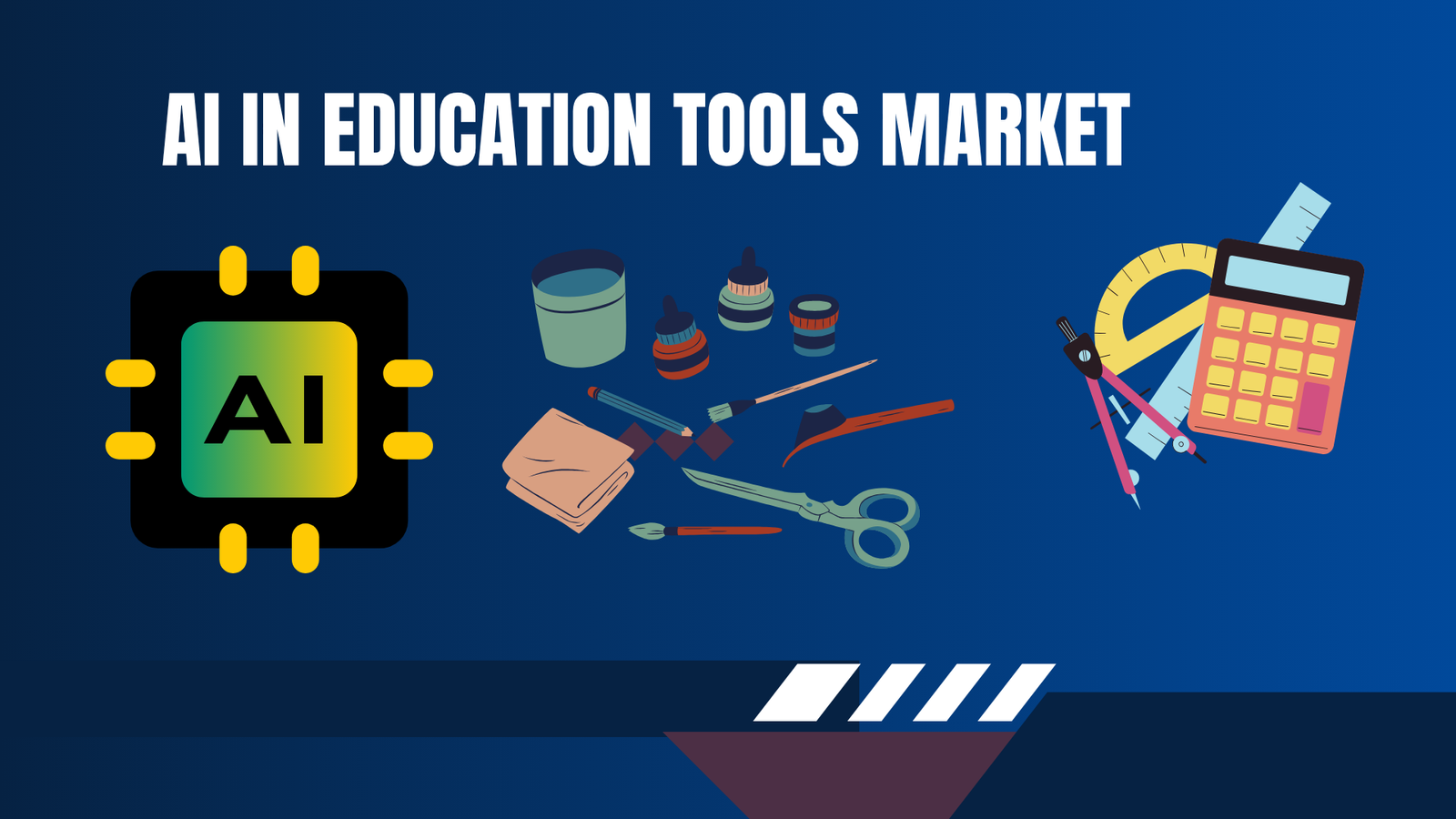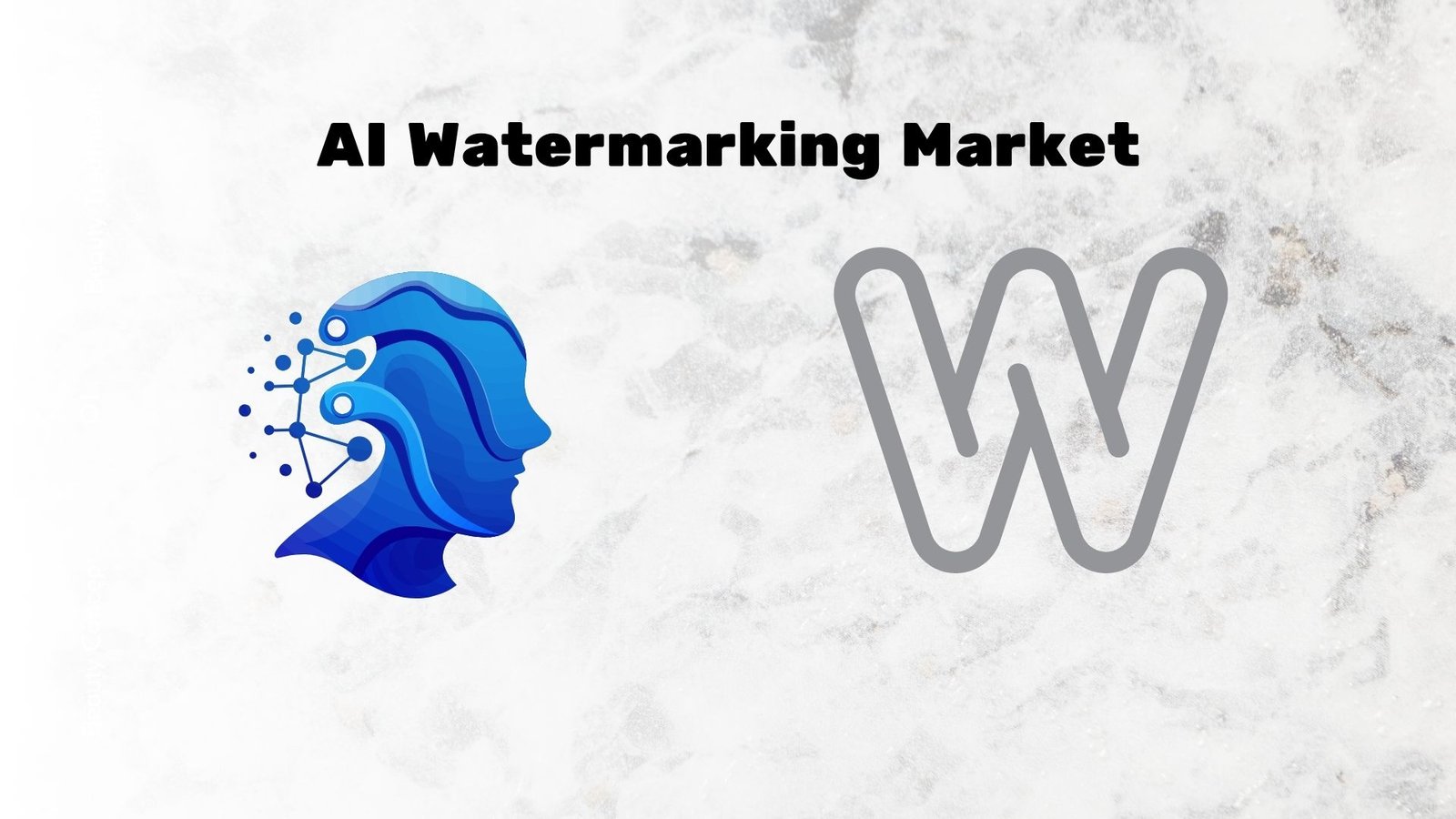Tech Diversity Statistics By Demographics, Countries And Facts (2025)
Updated · Jul 08, 2025
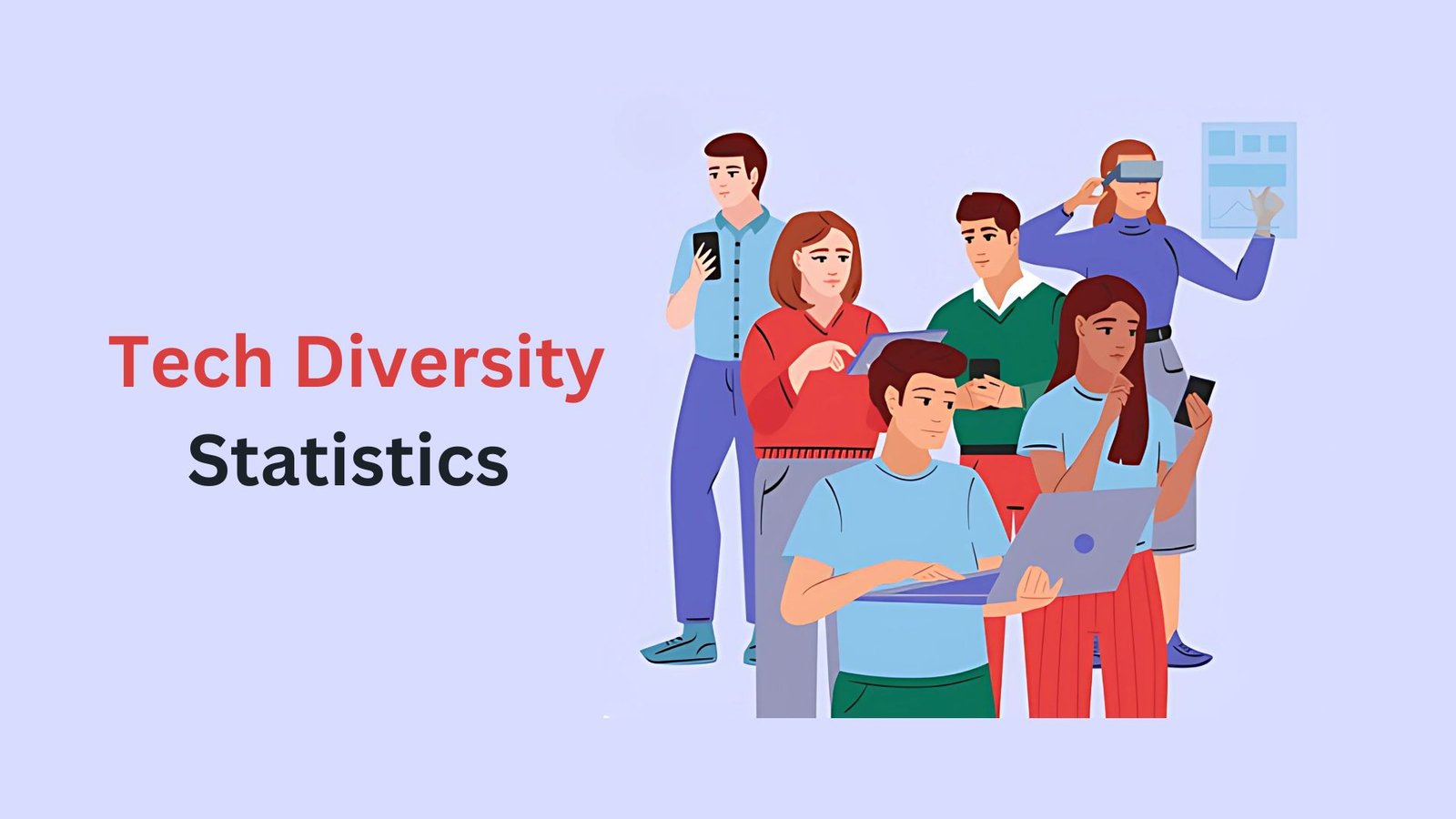
WHAT WE HAVE ON THIS PAGE
- Introduction
- Editor’s Choice
- What Is Tech Diversity?
- General Tech Diversity Statistics
- Tech Diversity Demographics Statistics
- Importance Of Diversity In Tech Statistics
- Diversity In Tech by Countries
- Women In Tech Diversity Statistics
- LGBTQ+ Inclusion in The Workplace Statistics
- Artificial Intelligence And Tech Diversity Statistics
- Diversity In the Tech Industry – Disability Statistics
- Racial Disparities In Tech Employment
- Tech Industry Jobs
- Conclusion
Introduction
Tech Diversity Statistics: Diversity and inclusion are continuous efforts with no endpoint. We can always do more to make the world a friendlier, supportive, and safe place for everyone, especially in the tech industry. Even though tech has been a mostly similar field in the past, we are gradually seeing more diverse professionals building successful and lasting careers in this area.
Tech covers many fields, including software development, cybersecurity, electronics manufacturing, and fintech. A degree in computer science or information technology can lead to many high-paying and in-demand jobs. Compared to other industries, tech offers higher salaries, quicker growth, and more job satisfaction. We shall shed more light on the Tech Diversity Statistics through this article.
Editor’s Choice
- Tech companies are increasingly adopting diversity and inclusion initiatives to address the growing awareness of inequalities in the industry.
- Many organizations are investing in programs to increase the number of women and minority groups in tech roles.
- Currently, 30.9% of new tech hires are women, and 11.3% of women in tech left the field last year.
- About 16.9% of women in tech received a promotion from their employer.
- Recent studies show that diverse teams are more creative and better at solving complex problems, which encourages the push for diversity initiatives.
- Tech leaders recognize that fostering a diverse and inclusive workplace is not only the right choice but also improves business results.
- Only 14% of workers in computer and math jobs in the US are Latinx.
- Apple had a 64% increase in employees from underrepresented groups from 2020 to 2023.
- 70% of organizations face challenges due to a lack of tech skills, causing them to lose 11% of their teams each year.
- Big companies like Google, Microsoft, and Apple have publicly committed to enhancing diversity within their organizations, signaling a shift toward greater accountability in the industry.
- Collaborations between tech companies, schools, and community organizations aim to create pathways for underrepresented groups to enter tech careers.
- New technologies, like artificial intelligence, are being used to reduce hiring biases and encourage more diverse recruitment.
- The focus on diversity in tech has led to more transparency and reporting on diversity metrics, allowing for better accountability and tracking of progress.
- Tech companies that conduct pay audits hire women at 1.3 times the rate of those without such audits.
- Finally, 57% of women reported feeling more burned out at work since COVID-19, compared to only 36% of men.
- Employee resource groups that focus on diversity and inclusion have become more common in tech companies. These groups provide support and advocacy for underrepresented employees.
- Diversity and inclusion are now key factors for investors and consumers, influencing their buying choices and investment strategies in the tech sector.
- Tech Diversity Statistics stated that around 56% of LGBTQ+ people in tech experience unfair treatment.
- White job applicants are offered an average of $144,000, while Black candidates get about $134,000.
What Is Tech Diversity?
Diversity in tech is vital for companies that want to stay connected to their customers and remain competitive in attracting talent. An inclusive workplace gives more people the chance to grow and succeed. This is an important step toward building stronger communities and a fairer world.
Businesses understand the importance of diversity. Workforce Management estimates that companies are spending billions of dollars on diversity and inclusion efforts. However, 68% of business leaders say their tech workforce needs more diversity.
There is still much to be done to improve diversity in the tech industry and tech roles in other sectors. In this article, we’ll explain why diversity in tech matters and what companies can do to improve it.
General Tech Diversity Statistics
- Only 3% of African American students are studying computer science, according to Code.org.
- Women make up just 24% of the tech industry workforce, as reported by NCWIT.
- According to data from the US Equal Employment Opportunity Commission, Hispanic workers represent only 8% of the tech workforce.
- According to the National Center for Women & Information Technology, only 26% of computing jobs in the US are held by women.
- LGBTQ individuals are greatly underrepresented in the tech industry, making up only 5% of the workforce, as per a study by TechRepublic.
- Asian Americans account for 27.7% of the tech workforce, according to the US Bureau of Labor Statistics.
- Based on data from the US Department of Labor, People with disabilities make up less than 1% of the tech workforce.
- LGBTQ+ individuals are more likely to experience discrimination and harassment in the tech industry, according to the Human Rights Campaign.
- Tech Diversity Statistics stated that only 2% of tech executives are Black, as reported by Boardlist.
- According to a report from the Kapor Center, Latinx individuals hold just 7% of computing jobs in the US.
- Only 5% of tech workers are Black, according to the US Equal Employment Opportunity Commission.
- The lack of diversity is even clearer at the executive level, where only 2% of leaders are Latinx, as reported by the Kapor Center.
- According to data from the US Equal Employment Opportunity Commission, women of colour make up only 11.9% of technical roles in the tech industry.
- LGBTQ individuals in tech are more likely to face bullying and harassment than their heterosexual peers, according to TechCrunch.
- Asian women hold just 3% of tech jobs in Silicon Valley, according to a study by Ascend as per Tech Diversity Statistics.
Tech Diversity Demographics Statistics
- The tech industry in the United States is diverse, both in terms of companies and people working in it.
- Massachusetts has the highest percentage of its population in tech, with about 6% working in the industry.
- Even though Massachusetts has 440,793 tech workers compared to California’s 1.86 million, its smaller population means it has more tech workers for each person. California and Virginia are close behind, with about 5% of their populations in tech.
Top Ten States by Tech Jobs
- California: 1,866,951
- Texas: 1,025,106
- New York: 679,083
- Florida: 585,296
- Virginia: 446,507
- Pennsylvania: 445,168
- Illinois: 441,205
- Massachusetts: 440,793
- Michigan: 412,324
- Ohio: 401,066
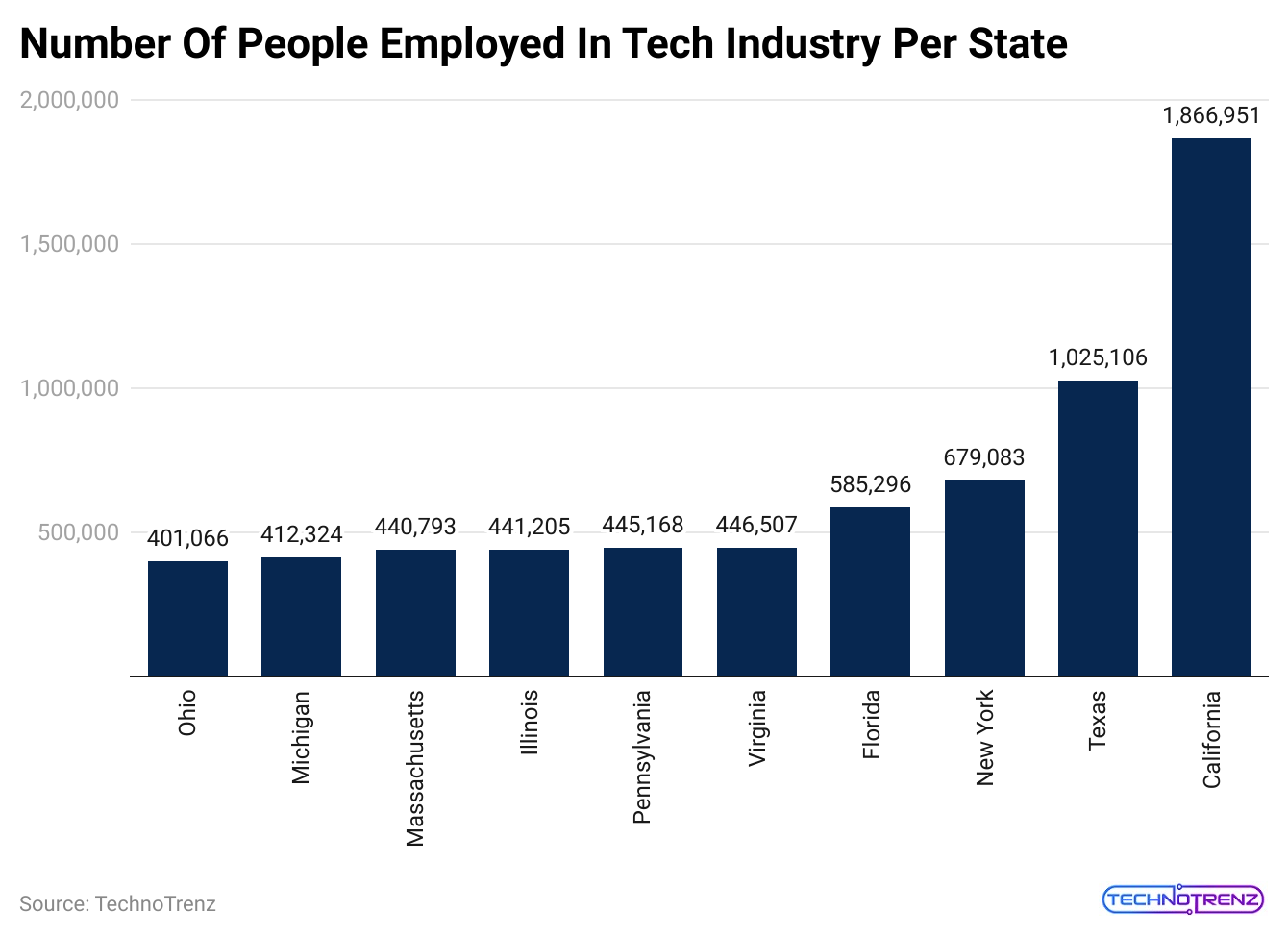 (Reference: scottmax.com)
(Reference: scottmax.com)
- As of 2023, the tech industry is mainly male, with men making up 73.3% of the workforce. The gender gap seems to be getting bigger, as women represent only 26.7% of tech employees.
- Additionally, women in the industry earn, on average, more than $3,000 less per year than their male counterparts.
- Tech Diversity Statistics stated that Asians represent just 5.4% of the total US population, but they make up 11.1% of the tech workforce.
- This difference is even more noticeable when looking at salaries; the average Asian tech worker earns over $7,000 more a year than their white coworkers and over $9,000 more than their Black coworkers.
- White individuals make up the largest group in the US tech industry, representing 61% of the workforce. However, this percentage has slightly decreased from 63.89% in 2022.
- In comparison, Black workers account for 12.1% of the US population but only 10.2% of tech industry employees. They also tend to earn the lowest average salaries in the industry, with an annual income of about $61,061.
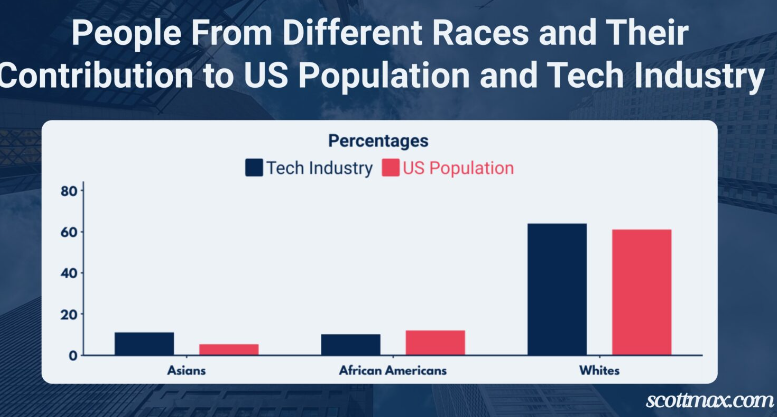 (Source: scottmax.com)
(Source: scottmax.com)
- About 55% of tech employees are 40 years old or older. This age group is much larger than the other two, with only 29% of tech workers between 30 and 40 and 16% aged 20 to 30.
- In other words, there are more tech workers aged 40 and above than the total of younger workers combined.
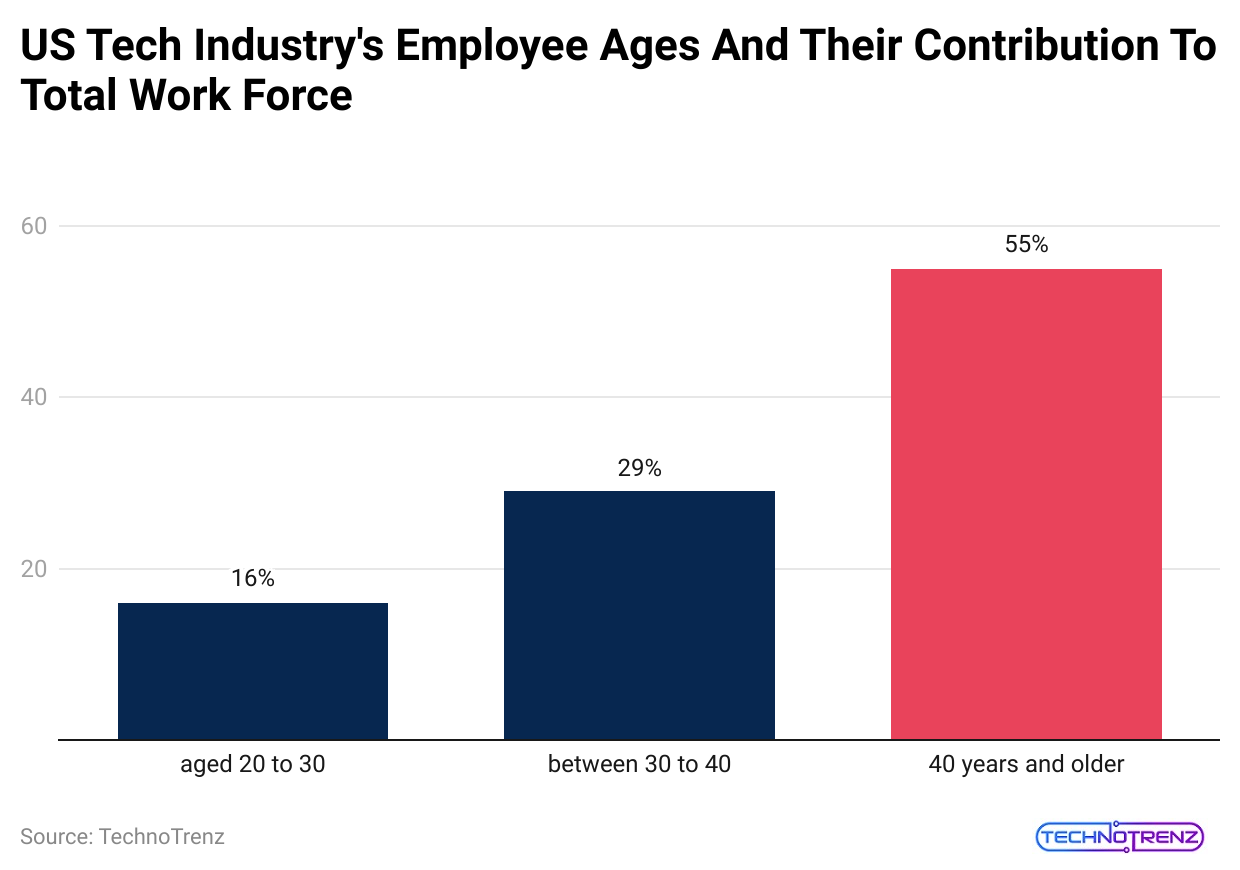 (Reference: scottmax.com)
(Reference: scottmax.com)
Importance Of Diversity In Tech Statistics
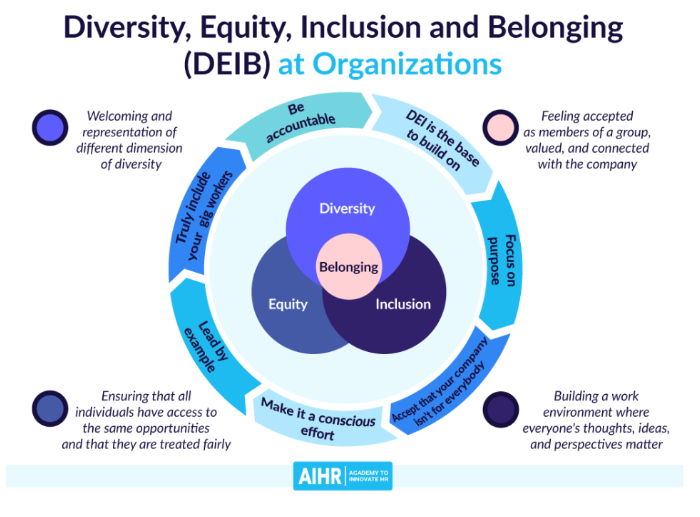 (Source: enterpriseappstoday.com)
(Source: enterpriseappstoday.com)
- With global IT spending expected to grow by 5.1% to reach $4.6 trillion in 2023, the tech industry is expanding much faster than almost all other sectors.
- As the field evolves quickly, many new jobs are being created. However, companies are struggling to find talent because there is a skills gap; the number of new professionals entering the industry isn’t keeping up with the rising demand for workers.
- When companies use strict hiring practices and overlook talented individuals from diverse backgrounds, the problem worsens and makes it harder to build and keep tech teams.
- By reviewing your hiring processes and promoting diversity, you can help close the skills gap and reduce its impact on your operations.
- Plus, you’ll gain the extra benefits that come with greater equality and inclusion, which can improve your workflows and company performance.
- Sadly, many still see equal opportunities and diversity as just a box to check, not realizing the positive effects a diverse team can have on the workplace and the entire business.
- Hiring diverse teams allows companies to benefit from a wider range of ideas, work styles, and skills, which can lead to better business performance, according to Tech Diversity Statistics.
- A McKinsey study found that companies with high gender diversity are 25% more likely to be profitable than those with low diversity.
- Similarly, companies with high ethnic diversity are 36% more likely to achieve above-average profits than those with low diversity.
- Additionally, Gartner’s research states that “75% of organizations with diverse and inclusive decision-making teams will exceed their financial goals,” and “gender-diverse and inclusive CIO teams perform 50% better on average than less diverse teams.”
- Many IT and AWS roles require problem-solving, innovation, and creativity, and these skills improve significantly when teams have different perspectives.
- By actively building diverse teams, companies can take advantage of the benefits that equality and inclusion provide.
- Supporting and keeping these employees will help businesses maximize their value and gain the economic advantages of having a diverse workforce.
Diversity In Tech by Countries
Statistics show how representation and inclusion in the IT sector vary across different countries.
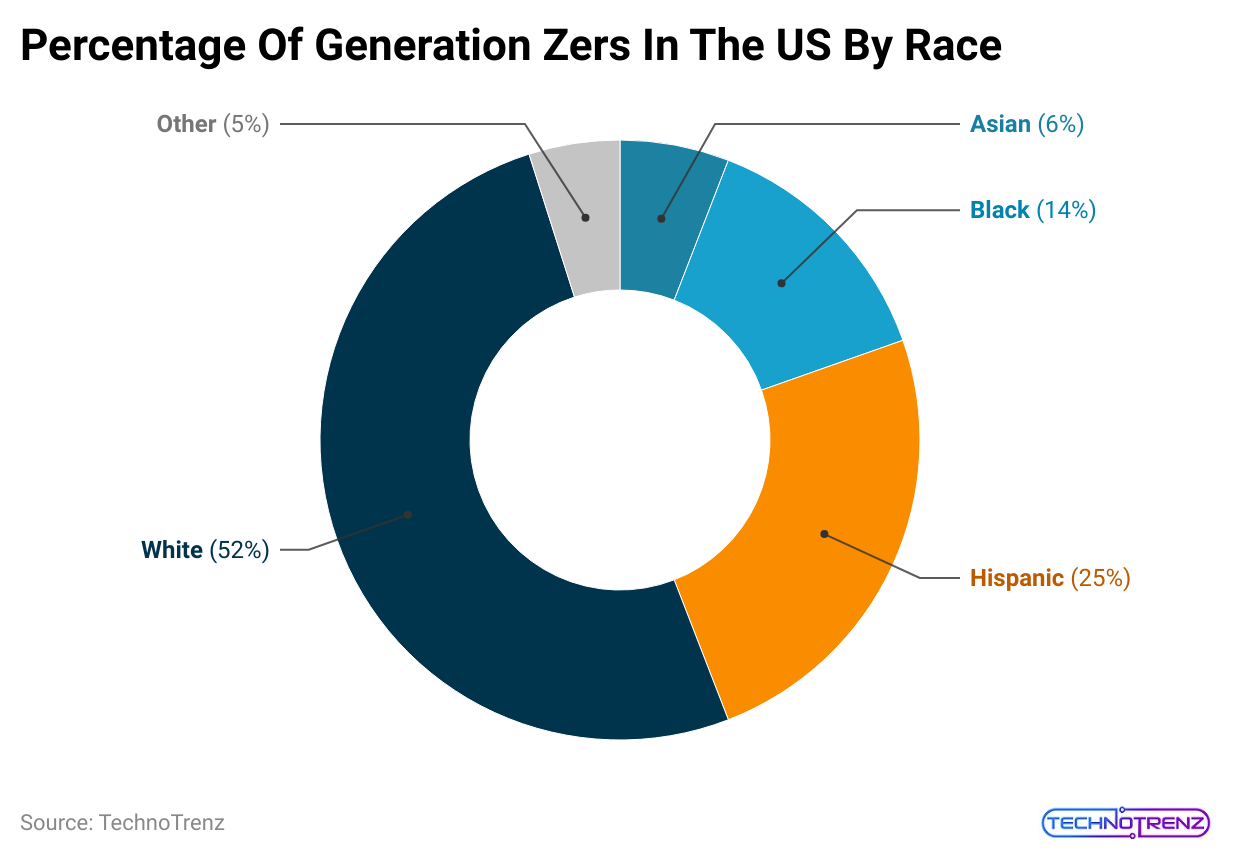 (Reference: enterpriseappstoday.com)
(Reference: enterpriseappstoday.com)
#1. US
- Women: According to the National Center for Women & Information Technology, about 26% of the computer workforce is made up of women.
- Racial and Ethnic Representation: The Equal Employment Opportunity Commission reports that Hispanics hold around 8% of IT jobs, while African Americans make up roughly 7%.
#2. UK
- Women: Tech Nation estimates that women account for about 19% of the tech workforce.
- Racial and Ethnic Representation: IT Nation states that Black, Asian, and Minority Ethnic (BAME) individuals represent approximately 15% of IT employees.
#3. Canada
- Gender Representation: Women make up about 25% of the computer industry workforce.
- Racial and Ethnic Representation: South Asian, Chinese, and Black communities account for around 22% of the IT sector workforce.
#4. Australia
- Women: According to the Australian Bureau of Statistics, women represent about 29% of Australia’s IT workforce.
- Racial and Ethnic Representation: The Workplace Gender Equality Agency reports that 11% of tech employees come from non-European backgrounds.
#5. Germany
- Gender Representation: Bitkom states that women make up about 16% of Germany’s tech workforce.
- Racial and Ethnic Representation: Bitkom also notes that 14% of IT workers are immigrants or come from migrant backgrounds.
#6. India
- Women: According to the National Association of Software and Service Companies, women represent about 34% of India’s IT sector.
- Racial and Ethnic Representation: While specific ethnic data isn’t available, most IT workers in India are of Indian heritage.
- These numbers may change based on the source and definitions used for different groups, as well as India’s unique demographic situation.
- Around the world, businesses, trade organizations, and governments are taking steps to improve diversity in IT.
- They are implementing diversity and inclusion policies, offering educational programs for disadvantaged groups, and creating equal opportunities.
- These efforts aim to promote diversity and provide support for underrepresented groups.
- The IT industry can also improve representation by considering different cultures and taking specific actions to encourage innovation, economic growth, and a fair work environment.
Women In Tech Diversity Statistics
- As of now, women hold only 26.7% of tech jobs, a decrease of 2.1% over the past few years.
- Out of a sample of 552,751 tech employees from 56 companies, 141,038 are women. Among these, 79,163 (56%) are women of color.
- Mid-size tech companies employ 53% of women in the industry. Six tech companies have equal representation of men and women at least one career level.
- Women’s representation in larger tech firms with over 10,000 employees is 26.2%. Overall, women in big tech dropped by 2.1% between 2022 and 2024.
- About 83.6% of tech companies say they have fair hiring and training practices, and 75.5% have established pay equity policies.
- At the internship level, women make up 39% of the tech workforce and hold 32.8% of entry-level computer science jobs.
- Tech Diversity Statistics stated that only 10.9% of CEOs or senior leaders are women.
- The standard for women in tech roles is 26%. Globally, women represent 47.7% of the total workforce, and in the US, 57.4% of women participate in the workforce, holding 50.4% of all jobs.
- Women make up 50.2% of the college-educated workforce in the US, while Canada has the highest representation at 61.3%.
- A survey found that 69.8% of women worldwide prefer paid jobs, compared to 66.5% of men. However, only 10% of people in C-suite roles are women.
- Black women CEOs earn up to 38% less than their White male counterparts, and only 2 Black women are Fortune 500 CEOs.
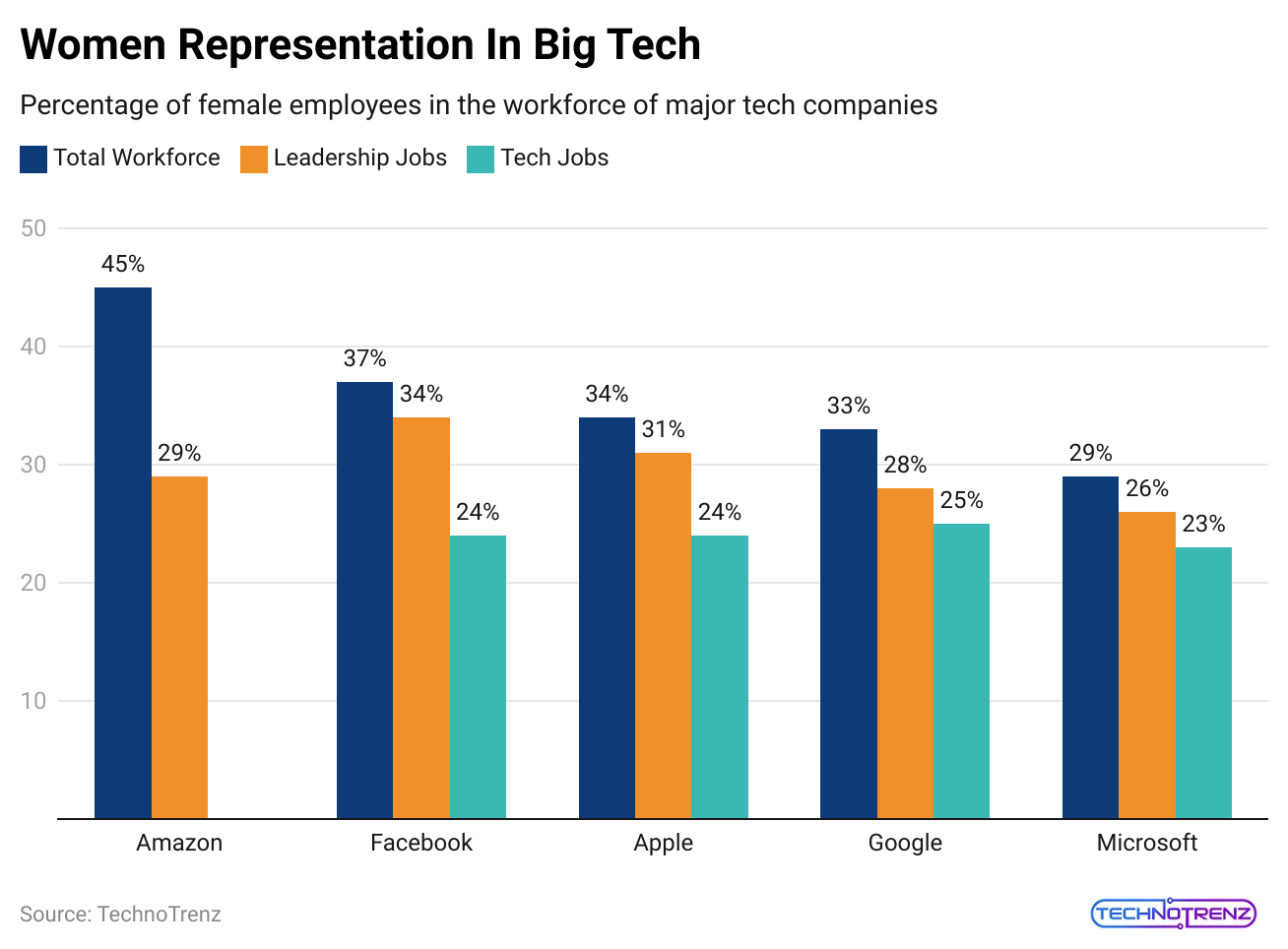 (Reference: bigblue.academy)
(Reference: bigblue.academy)
- Just 5.5% of the 3,000 largest American firms have female CEOs, as per Tech Diversity Statistics.
- Women-led startups have CEOs who earn 0.89 cents for every dollar made by male tech CEOs.
- Among 329,559 software engineers in the US, 25.1% are women. The majority of tech workers, both men and women, are White (52.3%).
- The average salary for software engineers is $86,157, but women in this field earn 93 cents for every dollar a male software engineer makes.
- Women hold 1 in 5 senior software engineering roles, and about 33% of the current workforce are Asian or Asian American.
- The Bureau of Labor Statistics predicts a 19% growth in computer science jobs by 2026.
- Despite this potential growth, fewer women are pursuing computer science degrees. In this field, women earn 94% of what men make, which is a smaller pay gap compared to other tech areas.
- Black and Hispanic women make up only 6.3% of computer science degree holders, while Asian men and women account for up to 25% of the workforce.
- The percentage of new tech hires who are women increased from 29.4% in 2023 to 30.9% in 2024.
- White women represent 10.9% of new hires, while Black, multiracial, Indigenous, Pacific Islander, and Latin women make up only 6% of new hires.
- Companies with mandatory bias training have a higher rate of female new hires at 34.5%, compared to 28.8% for those with voluntary training.
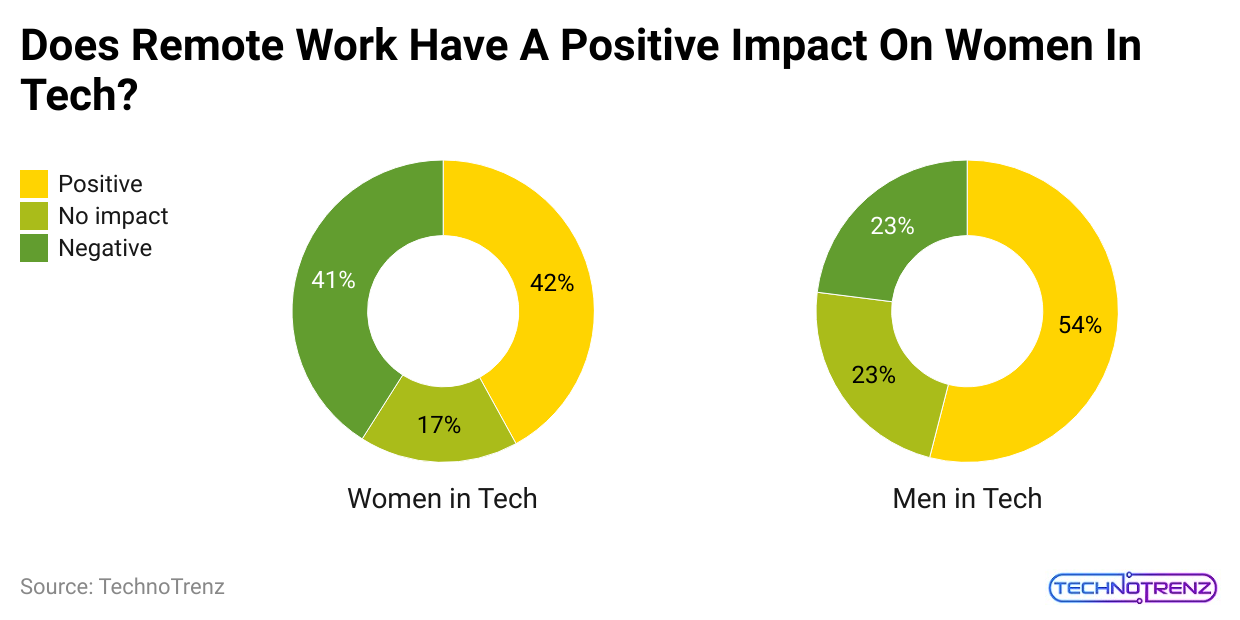 (Reference: sonary.com)
(Reference: sonary.com)
- Nearly half (48%) of women in tech report facing discrimination during hiring. About 39% see gender bias as a major barrier to tech jobs, and 66% feel there is no clear path to advancement in tech careers.
- Black women hold only 3% of computing jobs, and women are 22% more likely than men to experience “impostor syndrome” in tech and STEM fields.
- Around 50% of women report facing some form of gender discrimination or sexual harassment at work.
- About two-thirds (66%) of female entrepreneurs need help to get business funding.
- Women own around 40% of all businesses in the US, and 64% of new women-owned businesses have founders of colour. Since the pandemic, Latina-owned companies have grown by over 87%.
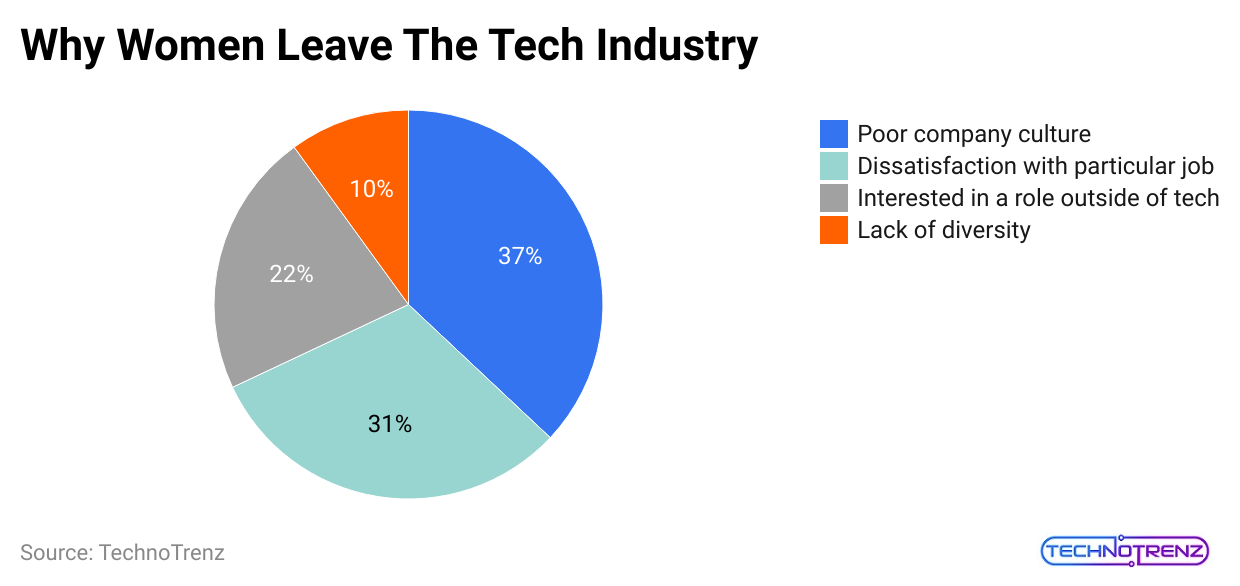 (Reference: bigblue.academy)
(Reference: bigblue.academy)
- Only 4.9% of venture capital deals are made to women-led businesses. However, more women in executive roles experience burnout, with 57% of women in tech reporting this issue.
- Women entrepreneurs tend to ask for about $35,000 less than their male counterparts, and they receive nearly $5,000 less in loans on average.
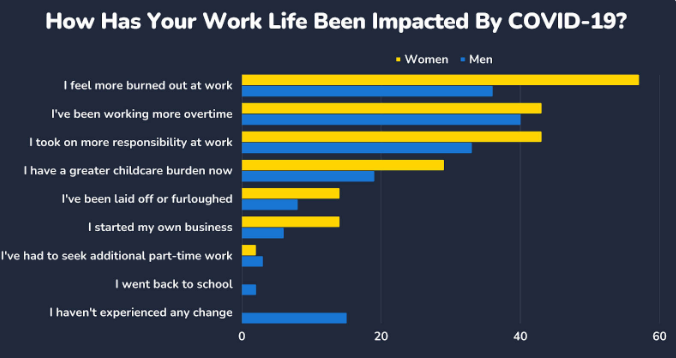 (Source: sonary.com)
(Source: sonary.com)
- Following COVID-19, 16.7% of workplaces established permanent remote work policies.
- Tech Diversity Statistics stated that about 54% of women said the pandemic made it harder to stay employed in tech jobs.
- Additionally, 42% of women reported burnout due to working during the pandemic, compared to 35% of men.
- Companies that balance male and female pay rates and advancement opportunities hire more women.
LGBTQ+ Inclusion in The Workplace Statistics
In 2022, LGBTQ workers in tech experienced more bullying and reported being overlooked for promotions because of their gender identity or sexual orientation. They witness comparisons related to how they express their gender and only 3% of tech professionals were known as LGBTQ that year.
- LGBTQ tech professionals frequently encounter microaggressions, which can hurt their work satisfaction and make them less likely to stay.
- They are 29% more prone to witness depression because of the workplace compared to their non-LGBTQ colleagues and often miss out on professional development chances.
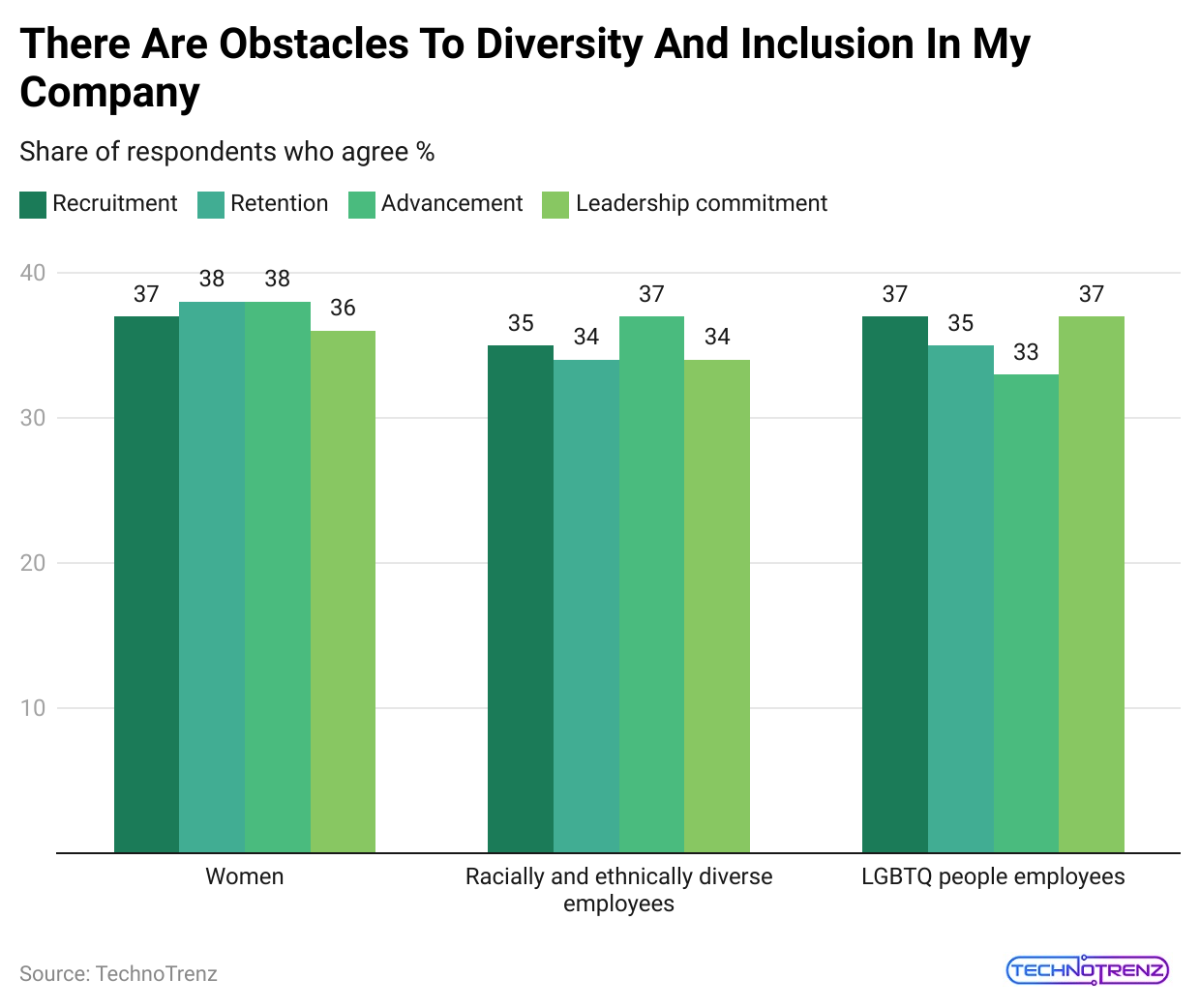 (Reference: esecurityplanet.com)
(Reference: esecurityplanet.com)
- Many LGBTQ tech employees lack mentorship and career growth opportunities.
- In 2023, they were the only group to see a drop in showcases in the tech industry. They are also more likely to leave their jobs due to a non-welcoming atmosphere, with retention rates 10-30% more than average.
- LGBTQ tech workers report facing microaggressions and higher rates of oral harassment and negative behavior at work.
- LGBTQ workers are underrepresented in the tech industry, making up just about 4% of the entire workforce.
- They tend to experience more discrimination at work than their straight colleagues and often feel uncomfortable sharing personal details.
- They may struggle with being “outed” without their consent and often have difficulty accessing appropriate healthcare benefits.
- These professionals are 40% more prone to being left out at work compared to their straight peers, and they are often left out of company events.
- There’s also a tendency for LGBTQ employees to be expected to represent their whole section in different initiatives.
- These employees frequently face a balance in hiring and promotions, and many feel pressured to hide or downplay their identities at work.
Artificial Intelligence And Tech Diversity Statistics
- AI is already changing how many tech companies work, and there’s still a lot of room for growth in this area.
- Even though AI has been in the news a lot, only 13.8% of businesses in the information sector currently use it to make products and services. However, many companies are planning to start using AI soon.
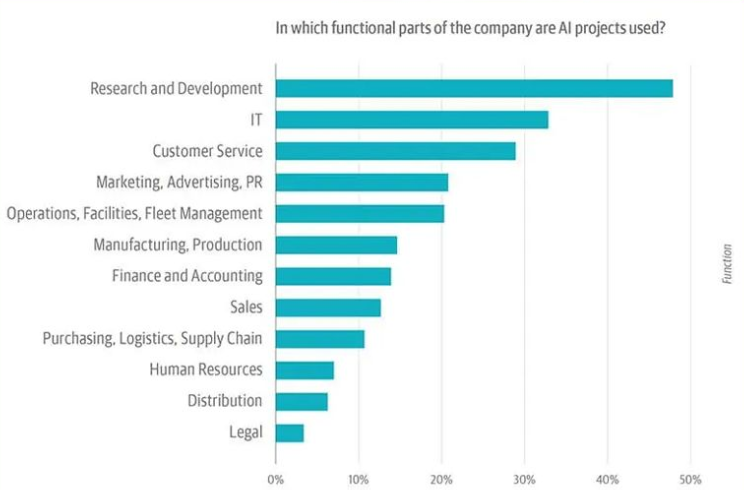 (Source: radixweb.com)
(Source: radixweb.com)
- In this sector, 21.8% expect to add AI capabilities in the next six months. For professional and technical services, 9.1% are using AI, and 15.2% plan to adopt it soon.
- According to the International Data Corporation (IDC), spending on AI will grow a lot. They predict that by 2027, worldwide spending on AI will reach $500 billion, with big companies spending over 40% of their IT budgets on AI.
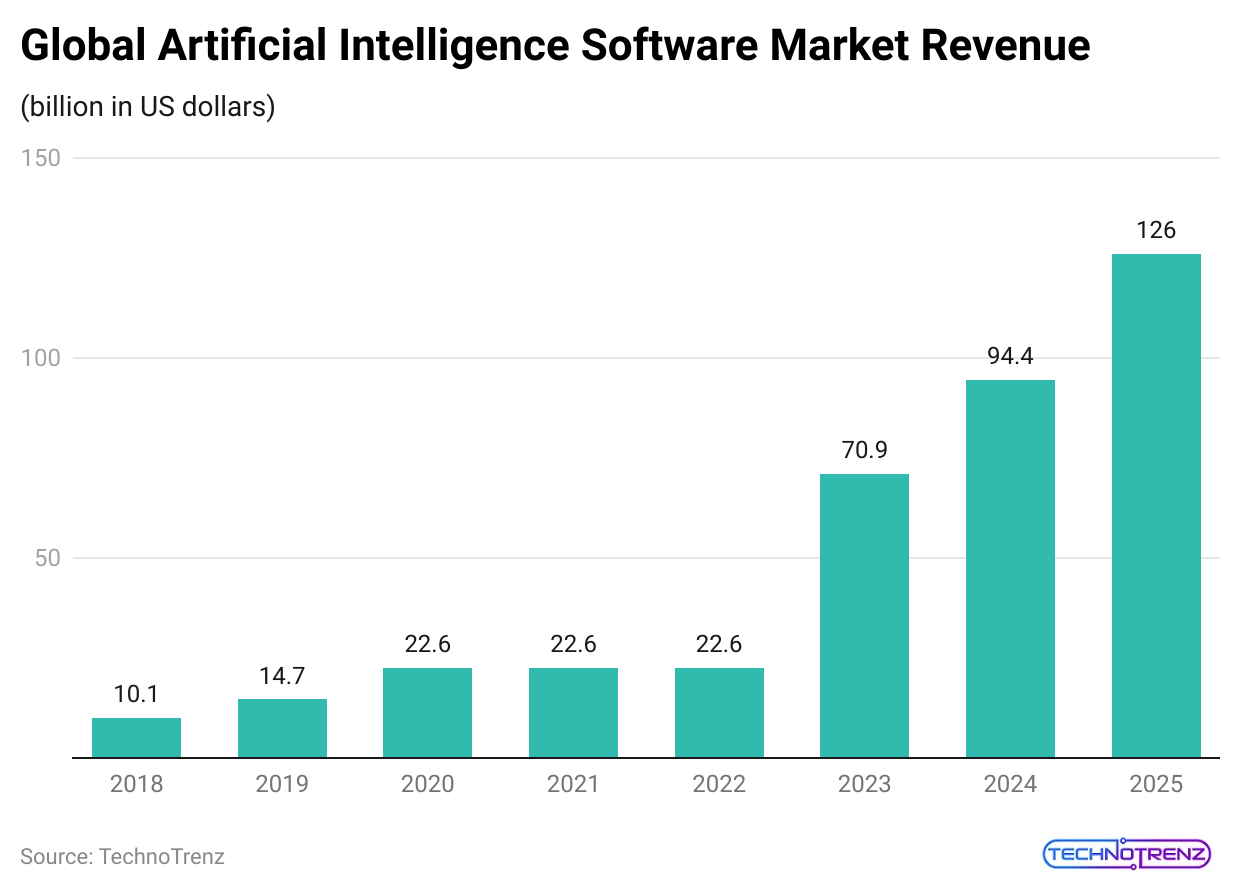 (Reference: radixweb.com)
(Reference: radixweb.com)
|
Year |
Revenue |
|
2025 |
$126 billion |
| 2024 |
$94.41 billion |
|
2023 |
$70.94 billion |
| 2022 |
$22.59 billion |
|
2021 |
$22.59 billion |
| 2020 |
$22.59 billion |
|
2019 |
$14.69 billion |
| 2018 |
$10.11 billion |
- While not all companies use AI to create products, many do use it in some form, as per Tech Diversity Statistics.
- A 2023 survey by PwC found that 73% of US companies use AI in some capacity. Generative AI tools, like ChatGPT, are the most popular, with 54% of companies reporting that they use them.
- Many Americans are worried about the rise of AI. In a 2023 study, only 39% thought that AI was safe, a decrease from the previous year.
- Additionally, 78% are concerned about AI being used for harmful purposes. More than half of working adults in the US fear that AI could take their jobs.
Diversity In the Tech Industry – Disability Statistics
- In the UK, about 19% of all workers have a disability. However, only 9% of IT specialists are disabled, according to techUK.
- Tech Nation’s People and Skills report for 2022 shows that tech job openings reached a ten-year high, with around 870,000 tech and digital jobs available from January to May 2022.
- Still, only 53.7% of disabled people in the UK were employed as of early 2023, showing a big gap in disability employment, especially in the tech field.
- To fix this, the government wants to increase the number of disabled workers to 1.2 million by 2027.
- They plan to improve existing programs like Disability Confident and Access to Work to make them easier for disabled applicants.
- Key changes include making hiring processes more accessible for disabled individuals and providing flexible work options.
- Employers are also encouraged to offer assistive technology and software to create a more inclusive workplace, according to Tech Diversity Statistics.
- By removing these obstacles, more disabled people can enter tech and other industries with many job openings.
- Big companies like Microsoft are also focusing on hiring disabled individuals. They hold Ability Hiring events, provide interview support, and have programs for neurodiverse people.
Racial Disparities In Tech Employment
- Black women in tech earn $0.90 for every $1 earned by white men in similar positions.
- Almost 76% of tech workers believe that minority groups face stereotypes in the industry.
- Only 4% of tech workers are over the age of 50.
- Immigrants make up nearly 25% of the tech workforce in the US.
- Nearly 3% of tech executives are Black.
- Disabled employees in tech are half as likely to have access to professional development compared to non-disabled workers.
- Only 22% of tech employees feel that their companies effectively address unconscious bias.
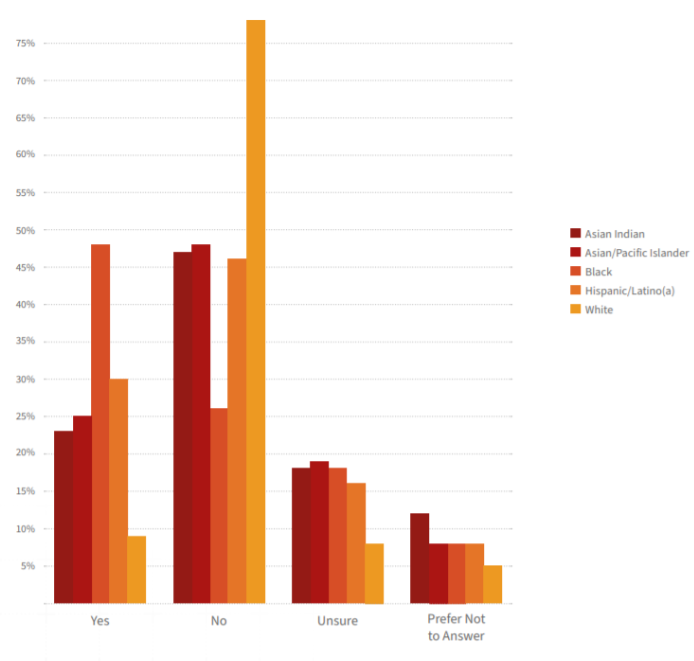 (Source: weforum.org)
(Source: weforum.org)
- Just 11% of tech companies have a specific budget for diversity and inclusion initiatives.
- Roughly 3% of African Americans and Hispanics have jobs in technology.
- Tech Diversity Statistics stated that Asians are the largest racial group in tech, making up 34% of workers.
- African American employees make up just 7.4% of the tech workforce.
- Latinx individuals represent only 8% of tech professionals.
- Almost 83% of tech executives in the US are white.
- Black women hold only 3% of computing jobs in tech.
- Women of colour make up just 5% of the tech workforce.
- 56% of Latinx workers in tech report facing discrimination based on their ethnicity.
- Only 2% of tech executives are Hispanic.
- Around 51% of Black employees in tech experience some form of racial discrimination.
- 25% of tech workers with disabilities say they feel discriminated against.
- The percentage of Black employees in tech has only increased by 2% in the last decade.
- Tech Diversity Statistics stated that only 6% of tech workers are Hispanic.
- Despite being nearly 20% of the US population, people with disabilities make up less than 1% of the tech workforce.
- 78% of tech executives believe their companies are inclusive, but only 36% of employees agree.
- People of colour hold just 12% of executive roles in tech.
- Tech Diversity Statistics stated that almost 29% of Black tech workers say they have been mistaken for janitors or administrative assistants.
- Only 3% of tech employees are veterans.
- Just 2.5% of employees in tech companies are disabled.
- Black professionals in tech have a 16% lower promotion rate than their white peers.
- Only 2% of tech workers identify as Native American or Alaska Native.
- The number of Black employees in tech has decreased by 1% over the past year.
- Asian professionals are the least likely to be promoted to management positions.
- Women of colour hold only 9% of managerial or professional jobs in tech.
- People with disabilities earn about 13-19% less than their non-disabled colleagues in tech.
- Native American tech workers are the least likely to receive mentorship and support.
- Black employees in tech states are witnessing microaggressions 2.8 times more often than their white coworkers.
- Just 10% of tech employees are military veterans, as per Tech Diversity Statistics.
Tech Industry Jobs
- The tech industry is known for offering high salaries and having a strong demand for workers.
- Computer and IT jobs have median wages that are more than double the national average for all jobs, and these positions are expected to grow much faster than most other careers over the next decade.
- About 377,500 new computer and IT jobs are expected to open each year from 2022 to 2032.
The fastest-growing jobs in this field include:
- Information Security Analysts: Projected growth of 32% from 2022 to 2032.
- Software Developers and Quality Assurance Analysts: Projected growth of 25%.
- Computer and Information Research Scientists: Projected growth of 23%.
- While all US jobs are expected to grow by 3%, computer and IT jobs are expected to increase by 14%.
- Information security analysts will see about 16,800 new job openings each year, while software developers will have 153,900 new openings.
- Most of these roles require a bachelor’s degree and are in high demand due to automation and rising cyber threats.
- The median annual salary for computer and IT jobs is $104,420, as per Tech Diversity Statistics.
- This is significantly higher than the median annual salary for all jobs, which was $48,060 in May 2023.
- Computer scientists, software developers, computer network architects, and information security analysts are among the top-paying tech jobs, and they all earn over $120,000 per year.
- Nearly 5 million people work in computer-related jobs, and this number is expected to grow to 5.6 million by 2032.
- Major employers in tech include companies in the tech sector, finance, information industries, and government.
- Computer jobs are projected to grow by 14.2% from 2022 to 2032, compared to just 3% for all occupations.
- Renewable energy, electrical equipment manufacturing, information services, and computer systems design are the fastest-growing industries for tech workers.
- About 24% of the US workforce is employed in STEM (science, technology, engineering, and mathematics) fields.
- As tech jobs continue to grow and industries rely more on technology, this percentage is likely to increase.
- According to the PwC 2023 global workforce survey, 64% of tech workers report being satisfied with their jobs, which is higher than the 56% satisfaction rate for all workers.
Conclusion
When examining diversity in the tech industry, it’s clear that there are still major gaps in representation among different groups. Women and ethnic minorities are often underrepresented in tech jobs, with their numbers much lower than the national average. More than half of female tech workers report experiencing gender discrimination, while many employees, especially black professionals, face racial inequality and harassment at work.
However, studies show that companies with diverse leadership teams usually perform better financially than those that lack diversity. This emphasizes the advantages of promoting inclusivity in the tech field. We have shed enough light on the Tech Diversity Statistics through this article.
Sources
FAQ.
Unconscious bias causes tech teams to become more alike because decision-makers often choose candidates who look or think like them. This can lead to slower career progress for some groups, higher turnover rates, and missed chances to hire diverse talent, which keeps the diversity gap wide.
A report from the Pew Research Center reveals that Black and Hispanic workers are not well represented in STEM (science, technology, engineering, and math) jobs. In fact, only 9% of all STEM positions in the US are held by Black workers.
Many reasons cause women to be underrepresented in technology jobs. Discrimination and bias in hiring processes create major barriers, leading to a culture that favors men in tech companies.

Barry loves technology and enjoys researching different tech topics in detail. He collects important statistics and facts to help others. Barry is especially interested in understanding software and writing content that shows its benefits. In his free time, he likes to try out new healthy recipes, practice yoga, meditate, or take nature walks with his child.



